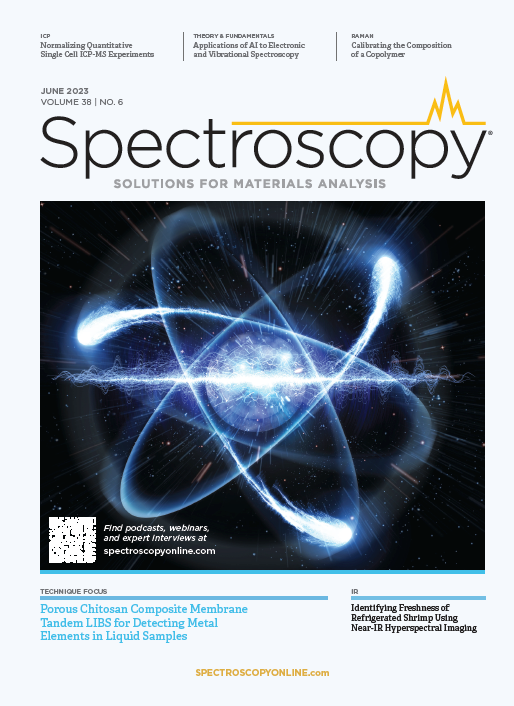Toward Normalization of Quantitative Single Cell ICP-MS Experiments
Because cells are heterogeneous materials appearing in many sizes and containing many different elements depending on the model, inductively coupled plasma–mass spectrometry (ICP-MS) is often used to conduct element analysis of single cells. Maria Montes-Bayón of the Faculty of Chemistry at the University of Oviedo (Asturias, Spain) has been working with single cell ICP-MS (sc-ICP-MS) to study the uptake and apoptotic status of nanoplatinum (IV) treated cells, specifically selenized yeast. Montes-Bayón recently spoke to Spectroscopy about this work.
What makes ICP-MS an effective technique in your experiments for single cell analysis?
Single cell -omics is a growing field of research, since cellular heterogeneity is what triggers the beginning of many diseases. Among single cell -omics techniques (such as genomics, trancriptomics, and proteomics), metallomics is also playing an important role, since metals are key regulators of cell functions. In addition, the monitoring of the differential uptake of drugs containing metals by individual cells might explain their effectiveness. The evaluation of the intracellular content of different elements in individual cells can be performed by ICP-MS using the previously established concept of single particle ICP-MS, considering some critical points (a cell is more sensitive to the analysis process than a particle). Through the years, we have been evaluating the suitability of different ICP-MS based strategies for single cell analysis and I would say we have found the most successful combination for the sensitive and sequential determination (with triple quadrupole-based mass analyzers) of single elements in single cells.
You’ve recently worked with selenized yeast as a reference standard. Why did you choose this standard, and what are the challenges involved in using these cells as a reference standard?
Different approaches are available for individual introduction into ICP-MS. To address the suitability of every system, different authors use different strategies. Reference materials are generally used to “validate” analytical results, but it is uncommon to have reference standards specifically for “cell-based” materials. We realized that selenium enriched yeast certified reference material, or SELM-1, was a yeast material that was certified in total Se content. While talking to microbiologists at our university, they noted that yeast cells were robust enough to be intact over time, and if preserved in the correct way, they should be alive. Thus, we started a multiple-techniques study on the suitability of the reference material (for example, using confocal microcopy of labeled cells, flow cytometry, and ICP-MS analysis). We also found it necessary to address the differential Se content intra- and extracellularly.
Are there any specific sample preparation and analysis conditions that are required to be successful in this analysis?
Indeed, we realized the importance of matrix effects when using ICP-MS. It seems strange that often something so well-known for so many years is not considered carefully when conducting this type of analysis. The paper we published establishes that the reference material can be used as such for sc-ICP-MS if carefully washed a few times and then dried before analysis. If this procedure is not followed, the accuracy of the results might be compromised when using external calibration.
Are there any sample cell types that are easier or more difficult to analyze, whether you learned this through testing or presume it from past experiences?
Yes. In our experience (our first paper is from 2017), we have researched yeast cells (Saccharomyces), bacterial cells (Streptomyces, Salmonella, E. coli),and human cells (A2780, A2780cis, OV-CAR3, A549, MCF-7, MDA-MB 231, STR-747, HepG2 corresponding to ovarian, lung, breast, and liver cancer cells). The first two models (yeast and bacteria) are much more resistant to the nebulization and transport into the plasma so the chance for leaking of the intracellular content into the sample matrix is minimized. With human models, it is much more challenging due to the delicate composition of the cell membrane that can be easily disrupted (see our TRAC paper 2020). In some cases, we fix the cells to minimize disruption, but this can be risky if constitutive elements need to be analyzed.
How does this work differ from what has been previously done by yourself or others?
This work tries to address the possible use of an already commercialized reference material to validate single cell ICP-MS analysis data. I think no one has used it for this purpose before.
Were there any limitations or challenges you encountered in your work?
Not really. We just could not believe the results we were obtaining on the unwashed samples, and we thought we were doing something wrong. We had a lot of brainstorming with the two post-docs in my office trying to understand why the results were 30% lower than expected. We even asked a more experienced post-doc to run the same sample and some PhD students to measure the same cell suspension every day to address transport efficiencies. It turns out that it was due to some matrix effects! It took us a while to understand this.
Can you please summarize the feedback that you have received from others regarding this work?
Very positive, and we have gotten some great collaborations started out of this work.
What are the next steps in this research?
We have some ideas to minimize the matrix effects when we will have access to a time-of-flight (TOF) instrument, which should happen shortly. In addition, our research is uniquely focused on single cell and single particle analysis, and we are conducting many collaborative projects. Collaborations, particularly from outside of analytical chemistry, are very important for success and understanding in this kind of research.
References
- Pereira, J. S. F.; Álvarez-Fernández García, R.; Corte-Rodríguez, M.; Manteca, A.; Bettmer, J.; LeBlanc, K. L.; Mester, Z.; Montes-Bayón, M. Towards Single Cell ICP-MS Normalized Quantitative Experiments Using Certified Selenized Yeast. Talanta 2023, 252, 123786. DOI: 10.1016/j.talanta.2022.123786
- Corte Rodriguez, M.; Álvarez-Fernández García, R.; Blanco, E.; Bettmer, J.; Montes-Bayón, M. Quantitative Evaluation of Cisplatin Uptake in Sensitive and Resistant Individual Cells by Single-Cell ICP-MS (SC-ICP-MS)Anal. Chem. 2017, 89 (21), 11491–11497 DOI: 10.1021/acs.analchem.7b02746
- Corte-Rodríguez, M.; Álvarez-Fernández, R.; García-Cancela, P.; Montes-Bayón, M.; Bettmer, J. Single Cell ICP-MS Using Online Sample Introduction Systems: Current Developments and Remaining Challenges. TrAC, Trends Anal. Chem. 2020, 132, 116042. DOI: 10.1016/j.trac.2020.116042
Maria Montes-Bayón is Full Professor in Analytical Chemistry in the Department of Physical and Analytical Chemistry at the University of Oviedo (Spain) since December 2017. She holds a bachelor’s degree in chemistry (1993, University of Oviedo, Spain), a bachelor-thesis in Analytical Chemistry (1994, University of Plymouth, UK and Oviedo), and a PhD (1999, University of Oviedo; awarded) degree. In the year 2000, she joined the research group of Prof. Joseph A. Caruso at the Department of Chemistry at the University of Cincinnati as a Postdoctoral Fulbright Fellow. She went back to Oviedo on a Senior Researcher contract and was promoted in 2008 to Associate Professor, and in 2017 was promoted to Full Professor of Analytical Chemistry. Her main research interests are: a) Development of quantitative strategies for determination of molecular biomarkers of clinical relevance at the single cell level using ICP-MS; b) Evaluation of encapsulated metallodrugs for their potential use in chemotherapy using mass spectrometry: a focus on cellular resistance mechanisms; and c) analytical tools to study biomedical aspects of nanoparticles: biogenic nanoparticles and metal nano-debris from metallic implants. She has supervised 14 PhD students since 2007 and mentor of 5 postdocs who built up a successful career afterwards. She has given >40 invited and plenary lectures in national and international congresses and conferences and co-authors 164 publications (80% in Q1; 32 with >50 citations), including original research articles, reviews, and several book chapters (with >5,300 total citations, H-index = 43). She has got funding through 29 international/national/regional research projects (12 of them as PI) and is associate editor of the journal Metallomics (RSC/OUP) since 2015. Currently, she has been elected as President of Spanish Society for Analytical Chemistry since 2022.


Investigating ANFO Lattice Vibrations After Detonation with Raman and XRD
February 28th 2025Spectroscopy recently sat down with Dr. Geraldine Monjardez and two of her coauthors, Dr. Christopher Zall and Dr. Jared Estevanes, to discuss their most recent study, which examined the crystal structure of ammonium nitrate (AN) following exposure to explosive events.
Distinguishing Horsetails Using NIR and Predictive Modeling
February 3rd 2025Spectroscopy sat down with Knut Baumann of the University of Technology Braunschweig to discuss his latest research examining the classification of two closely related horsetail species, Equisetum arvense (field horsetail) and Equisetum palustre (marsh horsetail), using near-infrared spectroscopy (NIR).